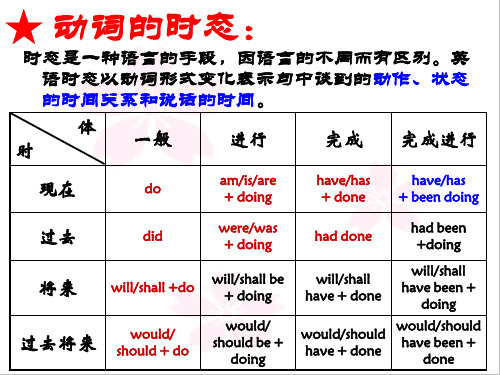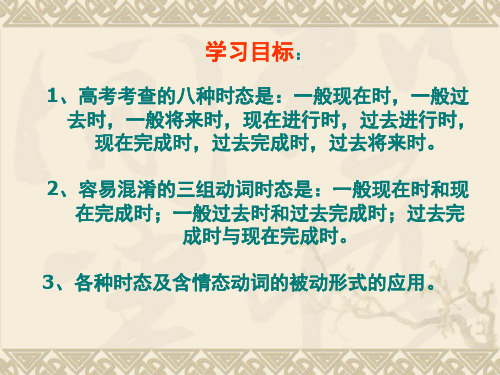动词时态与语态经典课件
合集下载
【英语语法】动词及其时态、语态PPT课件_OK

39
2)表示按计划安排过去将要发生的动作 • They were leaving for New York a few days later. • He was departing the next month.
40
3)与always, constantly, forever等连用, 表示某种感情色彩
26
3)某些非延续性动词,在现在完成时中,不能同表示一段时间的状语连用
• 常见的这类动词有:come, go, begin, start, become, leave, marry等
• 不可说 Harry has got married for six years.
• 可以说 Harry has been married for six
I have thought it over. 我已经考虑过这件事了。 I have been thinking it over.我一直在考虑这件事
33
五.一般过去时
(Simple Past) • 1. 构成:动词的过去式 • 2. 功能
34
1)表示过去某个特定时间或某一段时 间发生的动作或情况
23
三. 现在完成时
( Present Perfective)
• 1. 构成: have/has + -ed分词 • 2. 功能
24
1)表示说话时已经发生或尚未发生的 事态,着眼点在现在
• I’ve forgotten his telephone number. • He has been ill for a long time. • I haven’t seen the film.
playing
played
was /were had played playing
2)表示按计划安排过去将要发生的动作 • They were leaving for New York a few days later. • He was departing the next month.
40
3)与always, constantly, forever等连用, 表示某种感情色彩
26
3)某些非延续性动词,在现在完成时中,不能同表示一段时间的状语连用
• 常见的这类动词有:come, go, begin, start, become, leave, marry等
• 不可说 Harry has got married for six years.
• 可以说 Harry has been married for six
I have thought it over. 我已经考虑过这件事了。 I have been thinking it over.我一直在考虑这件事
33
五.一般过去时
(Simple Past) • 1. 构成:动词的过去式 • 2. 功能
34
1)表示过去某个特定时间或某一段时 间发生的动作或情况
23
三. 现在完成时
( Present Perfective)
• 1. 构成: have/has + -ed分词 • 2. 功能
24
1)表示说话时已经发生或尚未发生的 事态,着眼点在现在
• I’ve forgotten his telephone number. • He has been ill for a long time. • I haven’t seen the film.
playing
played
was /were had played playing
《动词时态和语态》课件

语态的用法
被动语态的构成: be+过去分词
被动语态的用法: 表示主语是动作的 承受者
被动语态的时态: 根据主语的人称和 数以及时间状语来 选择
被动语态与系表结 构的区别:被动语 态强调动作,系表 结构强调状态
动词时态和语态的搭配使用
一般现在时与被动语态的搭配使用 现在进行时与主动语态的搭配使用 过去完成时与被动语态的搭配使用 过去进行时与主动语态的搭配使用
写作练习
动词时态和语态的 基本概念和用法
不同时态和语态的 辨析与选择
写作中常见的时态 和语态错误及纠正 方法
练习题及答案解析
总结与回顾
总结重点内容
动词时态的种类和用法 语态的分类和用法 时态与语态的辨析和区别 常见错误和注意事项
回顾学习过程
动词时态的分类与 定义
动词时态的用法与 辨析
语态的分类与定义
练习与巩固
选择题练习
● 题目:下列句子中,动词时态使用正确的是( ) A. He _______ (buy) a new car last year. B. They _______ (play) football in the park yesterday. C. We _______ (study) English since 2010. D. They _______ (not finish) their homework yet. ● A. He _______ (buy) a new car last year. ● B. They _______ (play) football in the park yesterday. ● C. We _______ (study) English since 2010. ● D. They _______ (not finish) their homework yet.
专题10 动词的时态和语态(课件)-2024年中考英语复习(全国通用)

14.(2022·湖北武汉·统考中考真题)—I don’t think sixteen-year-olds should be allowed
to drive. —I ________. It’s not safe. A.agree B.agreed C.will agree
D.had agreed
apples in the fridge now.
A.is
B.are
C.was
D.were
【答案】A 【解析】句意:现在冰箱里有一些果汁和几个苹果。考查一般现在时及 “there be”。根据“now”,排除过去时态的CD,由于there be的就近原则, some juice不可数,所以应是is。故选A。
5.(2023·甘肃白银·校考一模)Thanks to those cleaners who ________ hard on the streets, we can have a beautiful city. A.work B.worked C.have worked D.were working
真理。
时态的辨析 满分秘籍
易失分点
提分特训
时态 谓语动词
意义
例句
一般
表示过去
过去 was/were,did 的动作或
时
状态。
When he was a child, he often swam in the river.当他小的时候,他经常在河里游泳。
16.(2023·江苏南通·统考一模)—What will the weather be like tomorrow? —I was on the phone and ________ most of the weather report. A.have missed B.was missing C.will miss D.missed
动词的时态与语态共67张PPT

was/were going to do 或 would do
the next day等
专题9 动词的时态与语态3
时态 现在进行时 过去进行时
现在完成时
过去完成时
结构 am/is/are doing was/were doing
has/have done
had done
常连用的时间状语
now, these days等 at this time yesterday, at that time, when引导的时间 状语从句等 already, yet, ever, never, so far, for three days, since two days ago等 before, when引导的时 间状语从句, by+过 去时间
结构 am/is/are+过去分词
was/were+过去分词 will be或is/are going to be+过去分词 has/have been + 过去分词
情态动词+be+ 过去分词
示例
All these things are made by machines.
This book was written by Lu Xun.
专题9 动词的时态与语6态
4.在现在完成时的句子中,如果有持续的时间状语,要把非延续性动词变为 延续性动词。如: I have had the book for two days. 这本书我已经买了两天了。(用had,而不用bought) How long may I keep the book? 这本书我可以借多长时间?(用keep,而不用borrow)
The meeting took place in a beautiful city. 会议在一座美丽的城市举行。 A fire broke out during the night.
动词的时态和语态-PPT课件

8. The man _h_a_d__h_o_p_e_d__ (hope) to catch the last train, but he was too late.
9. The boys __w_e_r_e_p_l_a_y_in_g___ (play) basketball from 5:00 to 6:00 yesterday.Βιβλιοθήκη .19练习
.
20
用所给动词的正确形式填空: 1. She _l_e_ft__ (leave) the office two
hours ago. 2. As son as she arrived home, the girl
discovered that she _h_a_d__t_a_k_e_n__ (take) her friends book by mistake. 3. Who _c_o_m__e_s__ (come) to school earliest in your class every morning? 4. Great changes _h_a_v_e_t_a_k_e_n_p__la_c_e__ (take place) in this city since 1979. 5. By the time he was twelve, Edison _h_a_d__b_e_g_u_n_ (begin.) to sell newspape21rs.
I’ll go to see you when I have time. I’ll go to see you if I have time tomorrow. 2. 某些动词,如:stand, continue, wish, love, like, hate, feel, find, think等常用一般现在时态
9. The boys __w_e_r_e_p_l_a_y_in_g___ (play) basketball from 5:00 to 6:00 yesterday.Βιβλιοθήκη .19练习
.
20
用所给动词的正确形式填空: 1. She _l_e_ft__ (leave) the office two
hours ago. 2. As son as she arrived home, the girl
discovered that she _h_a_d__t_a_k_e_n__ (take) her friends book by mistake. 3. Who _c_o_m__e_s__ (come) to school earliest in your class every morning? 4. Great changes _h_a_v_e_t_a_k_e_n_p__la_c_e__ (take place) in this city since 1979. 5. By the time he was twelve, Edison _h_a_d__b_e_g_u_n_ (begin.) to sell newspape21rs.
I’ll go to see you when I have time. I’ll go to see you if I have time tomorrow. 2. 某些动词,如:stand, continue, wish, love, like, hate, feel, find, think等常用一般现在时态
第一讲动词的时态和语态ppt课件

栏目 导引
火灾袭来时要迅速疏散逃生,不可蜂 拥而出 或留恋 财物, 要当机 立断, 披上浸 湿的衣 服或裹 上湿毛 毯、湿 被褥勇 敢地冲 出去
第二部分 语法专项突破
1.表示将来某一时刻的动作或状态常用以下四种结构: (1)will/shall+动词原形 (2)be going to+动词原形 (3)be to+动词原形 (4)be about to do sth. 2.基本用法 (1)一般将来时表示将来某一时刻的动作或状态,即单纯的将来 事实。 ◆ He will graduate from Beijing University next year. 明年,他将毕业于北京大学。
第二部分 语法专项突破
第一讲 动词的时态和语态
火灾袭来时要迅速疏散逃生,不可蜂 拥而出 或留恋 财物, 要当机 立断, 披上浸 湿的衣 服或裹 上湿毛 毯、湿 被褥勇 敢地冲 出去
一般时
一时态
第二部分 语法专项突破
一般现在时常用来表示习惯性、经常性发生的动作或存在的状 态。 1.谓语动词的构成:do/does(下面所有的谓语动词的构成皆以 do 为例) 2.基本用法 (1)表示经常性的动作 常与 usually, always, often, sometimes, never, every day 等表示 频度的时间状语连用。
栏目 导引
火灾袭来时要迅速疏散逃生,不可蜂 拥而出 或留恋 财物, 要当机 立断, 披上浸 湿的衣 服或裹 上湿毛 毯、湿 被褥勇 敢地冲 出去
第二部分 语法专项突破
[典例] (2015·全国卷Ⅱ)If you are able to come with us,please let us know and we ____________(wait) for you at the school gate at 9 in the morning.
高中英语语法 动词的时态、语态(共37张ppt)

❶表示在确定的过去时间里所发生的动作或存在的状态,常有表示过去时间的状语,或
有上下文暗示;还可表示 表示在过去一段时间内,经常性或习惯性的动作。
❷在时间、条件、让步状语从句中,若主句用了过去将来时,从句常用一般过去时表示
过去将来的意义。
❸有些动作发生的时间没有具体表明,但实际上是‘刚才,刚刚”发生,或者是表示说话人
1
问题诊断
2020/6/26
2
Ⅰ. 单句语法填空
1. Diets have changed in China—and so too has its top crop. Since 2011,the
country _h__a_s_g_r_o_w__n__ (grow) more corn than rice.(2018·全国卷Ⅱ)
were
2. It was Monday morning,and the writing class had just begin. (2018·全国卷Ⅲ)
begun
3.I had grown not only physically,but also mentally in the past few
I am going to buy some books with my sister this afternoon. 我打算下午和姐姐去买些书。 Look at the clouds. It is going to rain. 看那些乌云。天要下雨了。
2020/6/26
13
三、一般将来时
3 be to +动词原形, 表示按计划进行的动作或征求对方意见。还可 表示吩咐、命令、禁止、可能性等。
会20议20/6/2将6 于今天下午3点举行。
动词时态语态ppt课件

4) 用在一些句型里:
It is time you went to bed. I wish I were a bird. I'd rather you came tomorrow.
寒假来临,不少的高中毕业生和大学 在校生 都选择 去打工 。准备 过一个 充实而 有意义 的寒假 。但是 ,目前 社会上 寒假招 工的陷 阱很多
(客观安排) I’m going to play football tomorrow afternoon.
(主观安排)
■
现在进行时 寒假来临,不少的高中毕业生和大学在校生都选择去打工。准备过一个充实而有意义的寒假。但是,目前社会上寒假招工的陷阱很多
▲ 现在进行时的基本用法: a. 表示现阶段或目前正进行的动作。 We are waiting for you. Mr. Green is writing another novel this month.
doing
had done
had been +doing
will/shall have + done
will/shall have been +
doing
would/should have + done
would/should have been +
done
一般现在时的用法 寒假来临,不少的高中毕业生和大学在校生都选择去打工。准备过一个充实而有意义的寒假。但是,目前社会上寒假招工的陷阱很多 • 表示经常性或习惯性的动作或存在的状态,常
与表示频度的时间状语连用。 every…, sometimes, often, usually, on Sunday
I leave home for school at 7 every morning. He is alone.
It is time you went to bed. I wish I were a bird. I'd rather you came tomorrow.
寒假来临,不少的高中毕业生和大学 在校生 都选择 去打工 。准备 过一个 充实而 有意义 的寒假 。但是 ,目前 社会上 寒假招 工的陷 阱很多
(客观安排) I’m going to play football tomorrow afternoon.
(主观安排)
■
现在进行时 寒假来临,不少的高中毕业生和大学在校生都选择去打工。准备过一个充实而有意义的寒假。但是,目前社会上寒假招工的陷阱很多
▲ 现在进行时的基本用法: a. 表示现阶段或目前正进行的动作。 We are waiting for you. Mr. Green is writing another novel this month.
doing
had done
had been +doing
will/shall have + done
will/shall have been +
doing
would/should have + done
would/should have been +
done
一般现在时的用法 寒假来临,不少的高中毕业生和大学在校生都选择去打工。准备过一个充实而有意义的寒假。但是,目前社会上寒假招工的陷阱很多 • 表示经常性或习惯性的动作或存在的状态,常
与表示频度的时间状语连用。 every…, sometimes, often, usually, on Sunday
I leave home for school at 7 every morning. He is alone.
动词时态和语态总结.ppt

----Well , it _____ me.
A. isn’t B. wasn’t C. hasn’t been D. hadn’t been
2.----I’ve bought a box of chocolates for our daughter. ---Oh, how good a dad! But she doesn’t like sweet things. _____ that?
2. be going to do ①表示已经决定或安排好要做某事。 We are going to visit the Museum of Chinese History. ②根据某种迹象认为在最近或将要发生某事。 Tom studies very hard, and he is going to try for a scholarship.
学习目标:
1、高考考查的八种时态是:一般现在时,一般过 去时,一般将来时,现在进行时,过去进行时, 现在完成时,过去完成时,过去将来时。
2、容易混淆的三组动词时态是:一般现在时和现 在完成时;一般过去时和过去完成时;过去完 成时与现在完成时。
3、各种时态及含情态动词的被动形式的应用。
突破方法:
1、不可脱离语境学习时态和语态,而是要在了解了八种 常用时态的一些常用规则后,留心以英语为母语者在 实际生活中如何使用各种时态和语态。
常与last week/year/ month/ spring, a few days ago, in 1998等时间状语以及when等连词引
导的时间状语从句连用。
We had a good swim last Sunday. When I was young, I took cold baths regularly.
A. isn’t B. wasn’t C. hasn’t been D. hadn’t been
2.----I’ve bought a box of chocolates for our daughter. ---Oh, how good a dad! But she doesn’t like sweet things. _____ that?
2. be going to do ①表示已经决定或安排好要做某事。 We are going to visit the Museum of Chinese History. ②根据某种迹象认为在最近或将要发生某事。 Tom studies very hard, and he is going to try for a scholarship.
学习目标:
1、高考考查的八种时态是:一般现在时,一般过 去时,一般将来时,现在进行时,过去进行时, 现在完成时,过去完成时,过去将来时。
2、容易混淆的三组动词时态是:一般现在时和现 在完成时;一般过去时和过去完成时;过去完 成时与现在完成时。
3、各种时态及含情态动词的被动形式的应用。
突破方法:
1、不可脱离语境学习时态和语态,而是要在了解了八种 常用时态的一些常用规则后,留心以英语为母语者在 实际生活中如何使用各种时态和语态。
常与last week/year/ month/ spring, a few days ago, in 1998等时间状语以及when等连词引
导的时间状语从句连用。
We had a good swim last Sunday. When I was young, I took cold baths regularly.
- 1、下载文档前请自行甄别文档内容的完整性,平台不提供额外的编辑、内容补充、找答案等附加服务。
- 2、"仅部分预览"的文档,不可在线预览部分如存在完整性等问题,可反馈申请退款(可完整预览的文档不适用该条件!)。
- 3、如文档侵犯您的权益,请联系客服反馈,我们会尽快为您处理(人工客服工作时间:9:00-18:30)。
——还没呢,房子还在粉刷呢。(未完性)
Selecting a mobile phone for personal use is no easy task because technology is changing so rapidly. 选手机供个人使用不是一件容易事,因为技术变化 太快了。(“变化”尚未结束)
②与 always/constantly/continually/forever/all the time 等表示时间的副词连用,表示说话人对主语的行为 表示赞叹、赞许、表扬、抱怨、厌恶等情绪,体现 出一定的感情色彩。如:
She is always asking the same question.
Whatever you say, I will not change my mind.
(2)一般过去时(did) ①一般过去时主要用来表示过去某个时间完成的动 作或一度存在的状态,常跟一个表示过去的时间状 语连用,如:then,yesterday,the other day等。有 时省去时间状语,但从上下文语境当中能体会出被 省略的部分。 语境中的一般过去时往往表示“刚才,在过去”, 暗示现在已“不再这样”。如:
—It's 9568442.
—Nancy is not coming tonight.
—But she promised.
②一般过去时还可以表示过去一段时间经常反复发 生的行为或习惯性动作,往往与used to,would等连 用。 When we were boys we used to/would go swimming every summer. 小时候,每年夏天我们都要去游泳。
(2) 过去进行时(was/were doing) ①过去进行时主要表示在过去某一时刻或某一时段 正在进行的动作,这一特定的时间 ( 时刻 ) 除了上下 文暗示之外,还有时间状语如: at that time/at this time yesterday/at that moment或when/while等引导的 状语从句表示。 ②与 always/constantly/continually/forever 等频度副词 连用时具有一定的感情色彩,一般表示说话人对所 描述的时间里发生的事情持批评或表扬的态度。表 示过去经常发生的动作。如:
玛丽在这家工厂工作过5年。
I went to Beijing 3 times last year. 去年我去过北京3次。
(3)一般将来时 ①“will +动词原形”表示现在看来以后要发生的动 作或存在的状态;事物的固有属性或必然趋势。如: Tom will come back next week.
第二节 动词的时态和语态 (2)
考点一:动词的时态
英语中动词的时态变化根据时间分为现在、过 去、将来和过去将来;根据动作方式分为一般、进 行、完成和完成进行,两种分类结合便产生了 16 种 时态。
下面以 do 为例,将 16 种时态的构成形式列表如
下:
巧学妙记:
1.时态的一般体 (1)一般现在时(do,does) ①一般现在时表示现在的经常性、习惯性动作或状 态 , 常 和 表 重 复 性 的 时 间 状 语 always , usually , often等连用。如: We have meals three times a day. 我们一日三餐。(现在的习惯) He is always ready to help others. 他总是乐于助人。(现在的状态)
He told me that he would pay me a visit if possible.
他说要是可能的话他会拜访我的。 下列方式也表示过去将来:
was/were going to do sth; was/were about to do, was/were to do表示过去曾经打算或计划将要做某事。
2.时态的进行体 一个长动作作为背景,被一个短动作打断,长动作 往往用进行体,短动作用一般体。 (1)现在进行时(am/is/are doing)
①表示在说话的瞬间正在进行或发生的动作或者是 当前一段时间内的活动情况或现阶段正在进行的动 作(在说话时不一定是正在进行)。在句中往往有now, just now等时间状语或是像Look!等提示词语,有的 则是通过上下文暗示某动作正在进行。
④两个或两个以上在过去接连发生的动作用and连接 时,要用一般过去时。如: He got up and dressed quickly. 他起床了并很快穿好了衣服。
⑤叙述某一动作或状态在过去持续了一段时间后终 止或在过去某段时间发生了若干次时用一般过去时。 如: Mary worked in this factory for 5 years.
他计划今晚到电视台讲话。
Look at the dark clouds. It is going to rain. 看这乌云,要下雨了。
③“am/is/are about to+动词原形”表示“立即的将来 (immediate future)”,因此,该句型很少与时间状语 连用。如: The train is about to start.
D .感官动词: see/look/hear/smell/taste/feel/sound 等。
⑤表示动作的未完性、暂时性。如: —Have you moved into the new house? ——你搬进新房了吗? —Not yet. The rooms are being painted.
②一般现在时还可表示客观真理、科学事实。如: The sun rises in the east and sets in the west. 太阳从东方升起,从西方落下。 ③一般现在时还可用在if,unless引导的状语从句中; 由when,before,until(till),as soon as,the moment, once 引 导 的 时 间 状 语 从 句 中 ; 由 no matter what/who/which/when/where/how 或 whatever , whoever , whichever , whenever , wherever , however引导的让步状语从句中。这时主句往往表示 将来(出现will/shall/can/must)或主句是祈使句。如:
⑤am/is/are to+动词原形 表示按计划或安排要做的事。如: When are you to leave for New York? 你什么时候去纽约?
(4)过去将来时 表示在过去看来将要发生的动作或存在的状态,用 “ would/should +动词原形”, should 仅用于第一人 称。具体运用时,多用于宾语从句或间接引语当中, 表示从过去的观点来看将来发生的行为或存在的状 态。如:
汤姆下周回来。
Fish will die without water.
鱼离开水就会死。
②“am/is/are going to +动词原形”表示“计划、打 算要做某事”,此外,am/is/are going to还可表示根 据现在的迹象,对未来进行推断。如: He is going to speak on TV this evening.
火车就要开了。
④有些动词如come,go,stay,arrive,leave,begin, start 等,其一般现在时、现在进行时也可表示按计 划、安排将来要发生的动作或状态。如: I arrive in Beijing at 3 p.m. tomorrow.
明天下午3点我到北京。
What are you going to do next week? 下周你打算做什么?
What are you doing next Sunday?
下周日你准备干什么?
④不可以用于进行时态的情况: A.表示存在状态的动词:be/stay/exist/belong to B.表示心理或情感状态的动词: fear/hate/remember/think/know/believe/want/need/unde rstand/forget/please/respect/prefer/mind/like/hope/wish/ agree/appreciate/recognize/mean/care/dislike/love等。 C.终止性动词不可以用于进行时: accept/allow/complete/hear/notice/end/admit/give/refus e/promise/decide等。
He was always ringing me up. 他过去老是给我打电话。
My grandfather was always forgetting things.
我祖父总是忘这忘那。
③come/go/leave/get/reach/start/set out/arrive等一些表 示趋向动作的动词用过去进行时可表示从过去某一 时间将要发生的动作,一般强调按计划、要求、打 算进行的动作。如: Mr. Smith said he was leaving for London soon. 史密斯先生说他马上就要去伦敦了。 She said she was coming to see her grandpa the next month.
This time next day they will be sitting in the cinema.
她总是问同样的问题。(表示厌恶) He is always thinking of others. 他总是为他人着想。(表示赞许)
③来、去、开始、终结、离开、到达等意义的终止 性动词的进行时表示按照计划安排好的将要进行的 动作。如: We are leaving for Japan tomorrow. 我们明天将离开去日本。
I'll go with you as soon as I finish my work. —Can I join in your club,Dad? —You can when you get a bit older. If city noises are not kept from increasing, people will have to shout to be heard even at the dinner table 20 years from now. Turn on the television or open a magazine and you will often see advertisements showing happy families. Don't try to run before you begin to walk.
